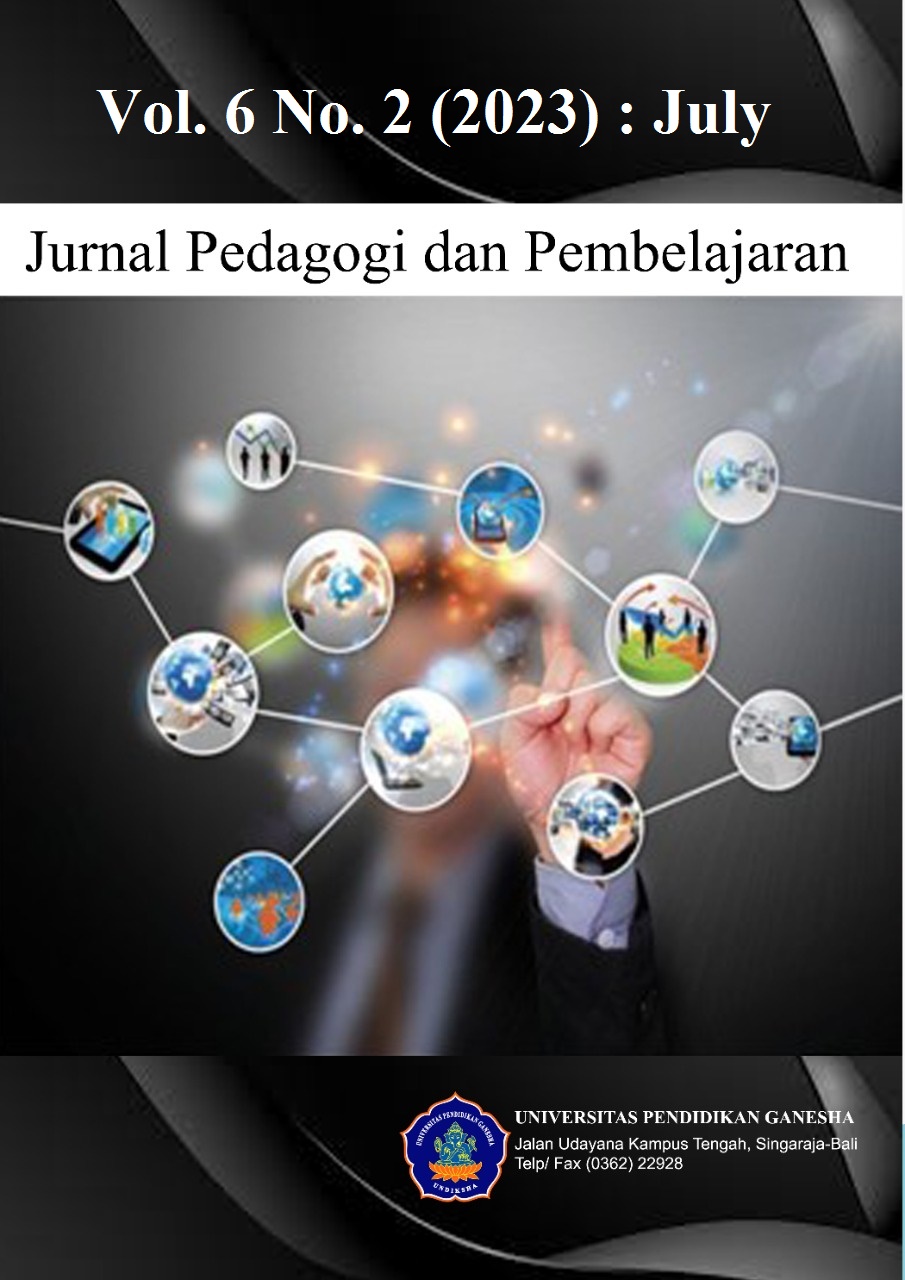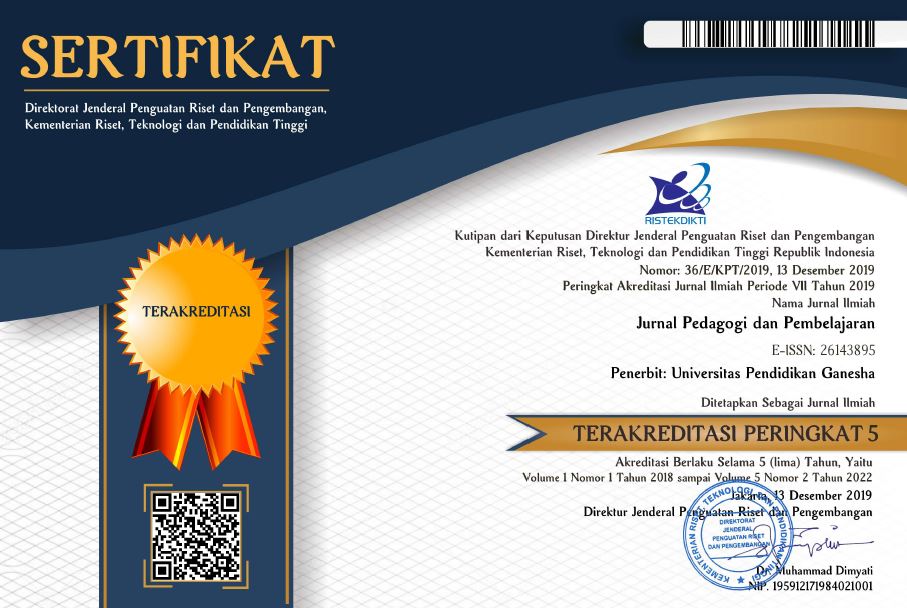Property Utilization in Creating Creative Dance
DOI:
https://doi.org/10.23887/jp2.v6i2.60452Keywords:
Creative dance, Dance property, Elementary schoolAbstract
Dance properties play an important role in helping dancers to move freely. The nature of dance needs to be developed and known by students in learning because it is very important as in learning the art of dance. The purpose of this study was to compare the utilization of tariff property with two indicators, namely messaging support and add artistic value at the elementary school level. This research method uses quantitative research with a sampling technique that is total sampling with a population of 68 students in four elementary schools. Types of Instruments in this study using a type of questionnaire instrument. Data analysis techniques used in this study are descriptive statistical tests and inferential tests in the form of assumptions and hypothesis tests. Based on the results of the study it can be seen that there are significant differences and comparisons in the utilization of tariff properties on the messaging support and add artistic value indicators in the four schools at the elementary school level. lack of dance properties in the school. So it is necessary to equalize property in various schools to increase the beauty of the dance performed by students. The implication of this research is knowing the importance of utilizing dance properties will have an impact on adding aesthetic value to dance students at the elementary school level.
References
Adzan, N. K., Pamungkas, B., & Juwita. (2021). Pengembangan Media Pembelajaran Tari Bedana Berbasis Android. Jurnal IKRA-ITH Humaniora, 5(1), 93–102. https://doi.org/10.17977/jptpp.v2i9.9958.
Arifin, Z. (2022). Manajemen Peserta Didik sebagai Upaya Pencapaian Tujuan Pendidikan. JurnalManajemendanPendidikanIslam, 8(1), 2503–3506. DOI: https://doi.org/10.26594/dirasat.v8i1.3025
Budiarti, R. S., Kurniawan, D. A., Septi, S. E., & Perdana, R. (2022). Differences and Relationship Between Attitudes and Self Efficacy of Female and Male Students in Science Subjects in Junior High School. Jurnal Pendidikan Sains Indonesia, 10(1), 73–88. https://doi.org/10.24815/jpsi.v10i1.21979. DOI: https://doi.org/10.24815/jpsi.v10i1.21979
Carr, C., Feldtkeller, B., French, J., Havsteen-Franklin, D., Huet, V., Karkou, V., & Sandford, S. (2021). What makes us the same? What makes us different? Development of a shared model and manual of group therapy practice across art therapy, dance movement therapy and music therapy within community mental health care. The Arts in Psychotherapy, 72(1). DOI: https://doi.org/10.1016/j.aip.2020.101747
Dewi, M. S. (2019). How the Fluency Aspect can Improve the Creative Dance Movement of the Children?. In International Conference on Arts and Design Education. In International Conference on Arts and Design Education (ICADE 2018), 102–104. https://doi.org/10.2991/icade-18.2019.23. DOI: https://doi.org/10.2991/icade-18.2019.23
Ernawati, M. D., Asrial, Perdana, R., Septi, S. E., & Rahmi. (2021). Evaluation of Students’ Attitudes and Science Process Skills toward Middle School Science Subject in Indonesia. Jurnal Pendidikan Progresif, 1(2), 258–274. https://doi.org/10.23960/jpp.v1. DOI: https://doi.org/10.23960/jpp.v11.i2.202110
Ferawati, Y., Hartono, H., & Triyanto, T. (2020). The Value of Creative Character of Guci Dance Through The Extracurricular Art of Dance. Catharsis, 9(3), 200–209. DOI: https://doi.org/10.15294/catharsis.v9i3.45220
Gunawan, G., Harjono, A., & Imran, I. (2016). Pengaruh Multimedia Interaktif dan Gaya Belajar Terhadap Penguasaan Konsep Kalor Siswa. Jurnal Pendidikan Fisika Indonesia, 12(2), 118–125. https://doi.org/10.15294/jpfi.v12i2.5018. DOI: https://doi.org/10.15294/jpfi.v12i2.5018
Gusmail, S. (2018). Properti Tari Waktu Dalam Lipatan: Analisis Semiotika Melalui Pendekatan Charles Sanders Peirce. Puitika, 14(1), 14–24. https://doi.org/10.25077/puitika.14.1.14--24.2018. DOI: https://doi.org/10.25077/puitika.14.1.14--24.2018
Hartono. (2010). Pemanfaatan media dalam pembelajaran tari di taman kanak kanak. Harmonia Journal of Arts Research and Education, 10(1), 1–10. https://doi.org/10.15294/harmonia.v10i1.46.
Hidayati, N. (2016). Konsep Integrasi Tripusat Pendidikan Terhadap Kemajuan Masyarakat. Edukasia : Jurnal Penelitian Pendidikan Islam, 11(1), 203–224. https://doi.org/10.21043/edukasia.v11i1.811. DOI: https://doi.org/10.21043/edukasia.v11i1.811
Jayanti, Y. D. (2020). Tari Kreatif Meningkatkan Kecerdasan Interpersonal Siswa. Equalita: Jurnal Studi Gender Dan Anak, 2(2), 227. https://doi.org/10.24235/equalita.v2i2.7433. DOI: https://doi.org/10.24235/equalita.v2i2.7433
Kamid, Sofnidar, Septi, S. E., & Citra, Y. D. (2021). The contribution of the traditional game of congklak to mathematics learning: How is the relationship and influence of interest, cooperative character and student responses. Premiere Educandum: Jurnal Pendidikan Dasar dan Pembelajaran, 11(2), 280–295. https://doi.org/10.25273/pe.v11i2.9995. DOI: https://doi.org/10.25273/pe.v11i2.9995
Kamid, Syaiful, Theis, R., Septi, S. E., & Widodo, R. I. (2021). Traditional “ Congklak ” Games and Cooperative Character in Mathematics Larning. Jurnal Ilmiah Sekolah Dasar, 5(3), 443–451. https://doi.org/10.23887/jisd.v5i3.37740. DOI: https://doi.org/10.23887/jisd.v5i3.37740
Kusuma, W. M., Sudira, P., Hasibuan, M. A., & Daryono, R. W. (2021). The Perceptions of Vocational School Students of Video Animation-Based Learning Media to Operate Lathes in Distance Learning. Journal of Education Technology, 5(2). https://doi.org/10.23887/jet.v5i2.33139. DOI: https://doi.org/10.23887/jet.v5i2.33139
Lestariani, L. P., Mahadewi, L. P. P., & Antara, P. A. (2019). Pengaruh model pembelajaran tari kreatif terhadap kemampuan motorik kasar kelompok b gugus I Kecamatan Banjar. Jurnal Pendidikan Anak Usia Dini Undiksha, 7(3), 236–245. https://doi.org/10.23887/paud.v7i2.19010. DOI: https://doi.org/10.23887/paud.v7i2.19010
Mantiri, J. (2019). Peran Pendidikan dalam Menciptakan Sumber Daya Manusia Berkualitas di Provinsi Sulawesi Utara. Jurnal Civic Education: Media Kajian Pancasila dan Kewarganegaraan, 3(1), 20. https://doi.org/10.36412/ce.v3i1.904. DOI: https://doi.org/10.36412/ce.v3i1.904
Melyza, A., & Aguss, R. M. (2021). Persepsi Siswa Terhadap Proses Penerapan Pembelajaran Pendidikan Jasmani Olahraga Dan Kesehatan Pada Pandemi Covid-19. Journal Of Physical Education, 2(1), 8–16. https://doi.org/10.21831/majora.v26i2.34589. DOI: https://doi.org/10.33365/joupe.v2i1.950
Novitasari, D., & Fitria, N. (2021). Gambaran Kompetensi Profesional Guru Paud Mangga Paninggilan Ciledug. Jurnal Anak Usia Dini Holistik Integratif (AUDHI), 3(2), 67–72. https://doi.org/https://doi.org/10.36722/jaudhi.v3i2.595. DOI: https://doi.org/10.36722/jaudhi.v3i2.595
Rama, P. K., & Antara, P. A. (2022). Media Pembelajaran Pop-Up Book Berbasis Pengenalan Motif Hias Bali Kelas III Pada Pembelajaran Seni Budaya dan Prakarya. Jurnal Ilmiah Pendidikan Profesi Guru, 5(2), 259–270. https://doi.org/10.23887/jippg.v5i2.49657. DOI: https://doi.org/10.23887/jippg.v5i2.49657
Ramalisa, Y., Septi, S. E., & Putri, F. I. (2022). Comparison of Two Learning Models on Students ’ Process Skills in Elementary School. Jurnal Ilmiah Sekolah Dasar, 6(3), 446–457. https://doi.org/10.23887/jisd.v6i3.48681. DOI: https://doi.org/10.23887/jisd.v6i3.48681
Ramli, S., Novanda, R., Sobri, M., Triani, E., & Septi, S. E. (2022). The Effect of Student Responses on Environmental Care Characters and Student Learning Outcomes. Eurasian Journal of Educational Research, 99, 112–126. https://doi.org/10.14689/ejer.2022.99.007.
Ravetto-Biagioli, K. (2021). Whose Dance Is It Anyway?: Property, Copyright and the Commons. Theory, Culture & Society, 38(1), 101–126. https://doi.org/10.1177/026327642092553. DOI: https://doi.org/10.1177/0263276420925534
Septi, S. E., Deswalman, D., Maison, M., & Kurniawan, D. A. (2022). Pengaruh Model Pembelajaran Discovery Learning Terhadap Keterampilan Proses Sains Siswa Pada Mata Pelajaran Fisika di SMAN 10. Jurnal Phi: Jurnal Pendidikan Fisika dan Fisika Terapan, 3(2), 6–13. https://doi.org/10.22373/p-jpft.v3i2.13225. DOI: https://doi.org/10.22373/p-jpft.v3i2.13225
Setiawan, D., Hardiyani, I. K., Aulia, A., & Hidayat, A. (2022). Memaknai Kecerdasan melalui Aktivitas Seni: Analisis Kualitatif Pengembangan Kreativitas pada Anak Usia Dini. Jurnal Obsesi : Jurnal Pendidikan Anak Usia Dini, 6(5), 4507–4518. https://doi.org/10.31004/obsesi.v6i5.2521. DOI: https://doi.org/10.31004/obsesi.v6i5.2521
Sholikhah, A. (2016). Statistik deskriptif dalam penelitian kualitatif. KOMUNIKA: Jurnal Dakwah Dan Komunikasi, 10(2), 342–362. https://doi.org/10.24090/komunika.v10i2.953. DOI: https://doi.org/10.24090/komunika.v10i2.953
Sibuea, T. R. (2022). Nias Dance Encyclopedia as a Source of the Working Process. Britain International of Linguistics Arts and Education (BIoLAE) Journal, 4(2), 197–207. https://doi.org/10.33258/biolae.v4i2.715. DOI: https://doi.org/10.33258/biolae.v4i2.715
Sugiarto, E., & Lestari, W. (2020). The collaboration of visual property and semarangan dance: A case study of student creativity in “Generation Z.” International Journal of Innovation, Creativity and Change, 10(12), 100–110.
Sugiyono. (2015). Metode penelitian pendidikan pendekatan kuantitatif, Kualitatif dan R&D. Alfabeta.
Sutini, N. M., Sanjaya, P., & Indrayasa, K. B. (2021). Pembelajaran Tari Kreatif Dalam Latihan Kemampuan Motorik Kasar Anak Pada Siswa Kelompok Bermain Werdhi Kumara Di Desa Belatungan Kecamatan Pupuan Kabupaten Tabanan. Nawa Sena: Jurnal PGPAUD, 1(2), 61–70.
Veliyanti, R., & Sasmoko, D. (2022). Sistem Pembelajaran Seni Tari Dengan Media Android Untuk Sekolah Dasar. Seminar Nasional Teknologi dan Multidisiplin Ilmu (SEMNASTEKMU), 2(1), 31–35. https://doi.org/10.51903/semnastekmu.v2i1.150. DOI: https://doi.org/10.51903/semnastekmu.v2i1.150
Wahyudi, A. V., Lutfatulatifah, Jayanti, Y. D., & Mulyana, A. (2022). Pelatihan Tari Kreatif Menggunakan Properti Tari Sebagai Media Eksplorasi Guru Paud Di Kecamatan Plumbon Kabupaten Cirebon. Abdimas Galuh, 4(9), 818–830. https://doi.org/10.25157/ag.v4i2.7661. DOI: https://doi.org/10.25157/ag.v4i2.7661
Yulianti, R. (2016). Pembelajaran tari kreatif untuk meningkatkan pemahaman cinta lingkungan pada anak usia dini. Jurnal Pendidikan Dan Kajian Seni, 1(1), 29–42. https://doi.org/10.30870/jpks.v1i1.851.
Downloads
Published
How to Cite
Issue
Section
License
Copyright (c) 2023 Destri Nelli, Suci Hayati, Aeron Frimals, Sabila Eka Septi, Fhadira Insani Putri

This work is licensed under a Creative Commons Attribution-ShareAlike 4.0 International License.
Authors who publish with Jurnal Pedagogi dan Pembelajaran agree to the following terms:- Authors retain copyright and grant the journal the right of first publication with the work simultaneously licensed under a Creative Commons Attribution License (CC BY-SA 4.0) that allows others to share the work with an acknowledgment of the work's authorship and initial publication in this journal
- Authors are able to enter into separate, additional contractual arrangements for the non-exclusive distribution of the journal's published version of the work (e.g., post it to an institutional repository or publish it in a book), with an acknowledgment of its initial publication in this journal.
- Authors are permitted and encouraged to post their work online (e.g., in institutional repositories or on their website) prior to and during the submission process, as it can lead to productive exchanges, as well as earlier and greater citation of published work. (See The Effect of Open Access)













